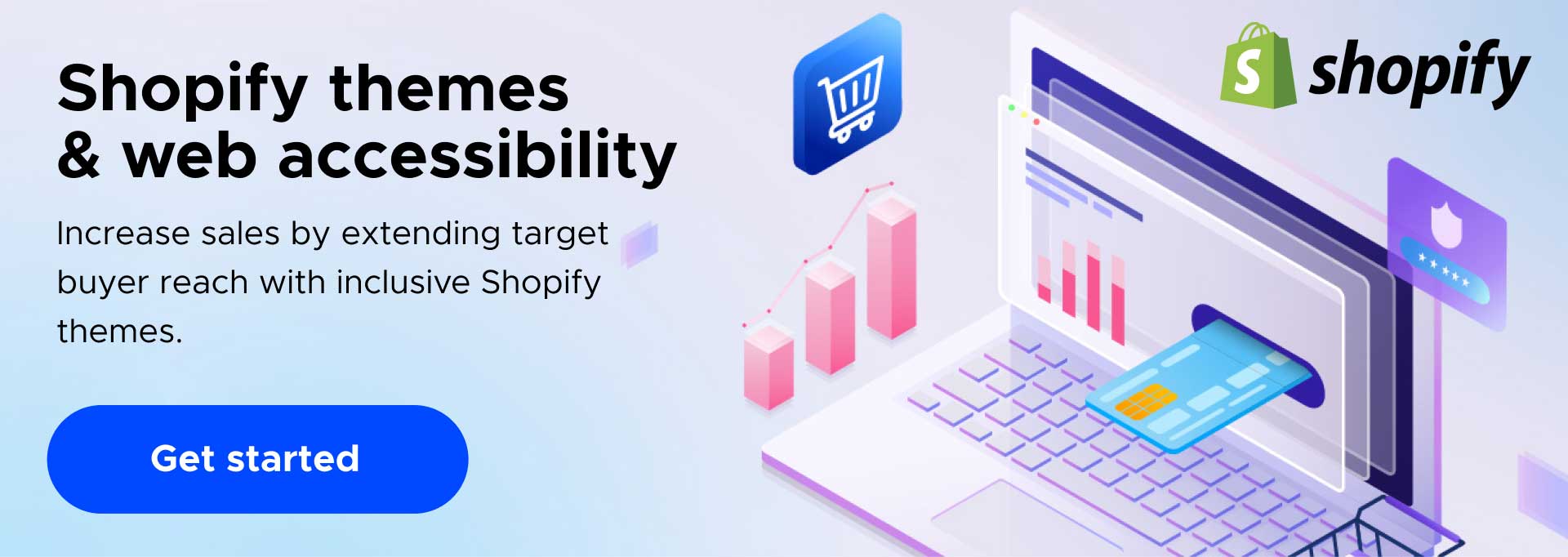Shopify Website Themes for Building an Accessible Storefront

Ready to expand your audience by establishing goodwill with consumers? It’s time to make a website that’s digitally accessible, and Shopify website themes can help.
Now you can broaden your audience to include people with disabilities, numerically the most significant global minority (over 1 billion people). It’s a wise approach to business and a preventative way to help mitigate costly accessibility-related lawsuits. But, most importantly, digital accessibility makes the web a fair and equal experience for everyone.
A Shopify theme is a group of files (graphics, style sheets, and code) that determine how your blog or site looks and functions. This article explains how you can use Shopify to create a digital storefront with accessibility in mind.
But first, let’s better understand Shopify and what it can do for your company.
What is Shopify?
Shopify is a comprehensive commerce platform that enables companies to start, expand, and maintain online storefronts. Because it’s exclusively cloud-based and hosted, you never have to upgrade or maintain software or web servers.
This cloud-based approach also means you can manage your site anywhere, anytime, even with your mobile device. Successful Shopify stores enable companies to sell products and services virtually anywhere, including online retailers, social media outlets, and physical stores.
Next, we look at the basic process of building a Shopify online store and then deep dive into making that site digitally accessible.
How to Create a Shopify Store in 5 Easy Steps
-
Step 1: Register & Get Started
After signing up for a Shopify account, visit the Shopify site to choose your email address, password, and storefront title. Next, you’ll specify the amount you want to sell and if you’re currently selling. Finally, click on the Enter My Store button after you finish.
-
Step 2: Integrate Products Into Your Storefront
After signing up, Shopify software automatically takes you to your new site’s admin screen. This screen is where you customize your store and upload products and related details (e.g., pricing, product names, and product descriptions).
-
Step 3: Modify Your Look & Feel
Return to the main dashboard to customize your site’s look and feel. Here you can modify anything from company logos to color schemes. The most important thing to address is visiting the Theme Store, where you can choose from hundreds of free and premium themes. Premium Shopify themes include additional modifications:
-
- Fonts
- Colors
- Page elements
- Functionality
- Rotating homepage slides
- Logos
-
Step 4: Setup Your Domain
Once you select from the numerous Shopify templates and design your site, choose a domain name to go live. Next, click Add a Domain in the dashboard to transfer or register a new domain, and follow the steps to complete your purchase.
-
Step 5: Activate Payments
Click the Payments tab to choose a payment processor like Stripe and Authorize.net.
But how can you improve web accessibility on a Shopify website? Read on to find out.
How to Start Building an Accessible Shopify Website
Here’s something you may not know but should: people with disabilities comprise a significant cross-section of the working population. Unfortunately, over 70% will leave your e-commerce storefront if it’s hard to navigate or understand. But an effective AI widget can help you build an accessible site for all ability levels.
Here are the recommended steps to follow:
1. Text Accessibility
In short, your online store’s text must be easily readable for people with visual impairments and those who struggle to read concentrated content sections. We break down specifics below:
Color Contrast: use an online contrast ratio tool to ensure you meet the appropriate guidelines:
- Body & Button Text: a minimum of 4.5:1 contrast ratio to the background color.
- Headings & Big-Text Format: a minimum of 3:1 contrast ratio to the background color.
Text Over Images: This includes slideshows, banners, and videos:
- Big Text (24 px & up): a minimum of 3:1 contrast to the background color.
- Small Text: a minimum of 4.5:1 contrast to the background color.
- Non-textual variables (e.g., borders, iconography): a minimum of 3:1 contrast to the background color.
Text size and alignment: Provide consistent spacing between words and letters so your text is big enough for maximum readability. Use at least 16 px for your body text font size, and justify text alignment for consistent spacing.
Text links: All links must be identifiable to all end users, including those who have difficulty recognizing color. The best approach is to underline text links and not rely on color to distinguish them from other content.
Text headings: Always present your headings sequentially for assistive technologies that use them to convey content organization and narrative.
2. Alt Text
End users with blindness or low vision often rely on screen readers and need special consideration. Alt text describes images for these customers so they understand how they relate to your site’s content and value proposition.
3. Slideshows & Videos
It’s critical to provide videos and slideshows that accommodate end users with vision and hearing-related disabilities. In addition, many site visitors need text-to-speech functionality (provided by screen readers) to hear webpage content aloud. Add closed captioning to ensure these customers can access and comprehend your content.
4. Keyboard Navigation
People with vision and motor-related disabilities often rely on keyboards to use websites. Provide keyboard navigation to these customers, whose conditions may prevent them from using a mouse.
Conclusion: Shopify Themes are an Excellent Start
Building a Shopify website is a relatively easy way to provide and maintain an online storefront. But you also need a site accessible to everyone, including people with disabilities. This blog is a terrific place to start, but multitudes of companies worldwide now rely on outside help for digital accessibility. The right third-party provider can offer efficiency, cost-effectiveness, and expertise to ensure your site is accessible and compliant with all crucial accessibility laws.
Learn why UserWay should be your first choice.
UserWay: Accessibility & Compliance Solved
UserWay is committed to making the web an equitable place for everyone worldwide. Over one million websites rely on its AI solutions to ensure accessibility and conformance to the most critical related laws. That includes robust support for Shopify storefronts.
Take the next big step by requesting a demo today
Answers to Common FAQs
Does Shopify Let Me Use My Domain?
Yes. Shopify does let you opt for your domain name. You can connect an existing one or purchase one from an outside provider.
Do You Need Design or Dev Experience to Use Shopify?
Not at all. The beauty of Shopify is that anybody can create and customize an e-commerce site for their business.
What Accessibility Laws Should I Follow for My Shopify Site?
It’s always best to comply with the ADA and WCAG to ensure your site is digitally accessible and legally protected.





Share